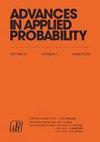随机切削模型的修正
IF 1.2
4区 数学
Q3 STATISTICS & PROBABILITY
引用次数: 0
摘要
我们提出了一种对图的随机破坏的改进:给定一个有限网络,具有一组不同的源和目标,随机去除(切割)顶点,丢弃不包含源节点的组件。我们研究了移除所有目标所需的切割次数,以及剩余图形的大小。该模型在Meir和Moon (J. Austral)的随机切割模型之间进行插值。数学。Soc. 11, 1970)和场地渗透。我们证明了几个一般结果,包括剩余图的大小是一个紧的随机变量族的相容序列的扩展型图,并确定了二叉毛虫树和完全二叉树的极限分布。本文章由计算机程序翻译,如有差异,请以英文原文为准。
A modification of the random cutting model
Abstract We propose a modification to the random destruction of graphs: given a finite network with a distinguished set of sources and targets, remove (cut) vertices at random, discarding components that do not contain a source node. We investigate the number of cuts required until all targets are removed, and the size of the remaining graph. This model interpolates between the random cutting model going back to Meir and Moon ( J. Austral. Math. Soc. 11 , 1970) and site percolation. We prove several general results, including that the size of the remaining graph is a tight family of random variables for compatible sequences of expander-type graphs, and determine limiting distributions for binary caterpillar trees and complete binary trees.
求助全文
通过发布文献求助,成功后即可免费获取论文全文。
去求助
来源期刊

Advances in Applied Probability
数学-统计学与概率论
CiteScore
2.00
自引率
0.00%
发文量
64
审稿时长
6-12 weeks
期刊介绍:
The Advances in Applied Probability has been published by the Applied Probability Trust for over four decades, and is a companion publication to the Journal of Applied Probability. It contains mathematical and scientific papers of interest to applied probabilists, with emphasis on applications in a broad spectrum of disciplines, including the biosciences, operations research, telecommunications, computer science, engineering, epidemiology, financial mathematics, the physical and social sciences, and any field where stochastic modeling is used.
A submission to Applied Probability represents a submission that may, at the Editor-in-Chief’s discretion, appear in either the Journal of Applied Probability or the Advances in Applied Probability. Typically, shorter papers appear in the Journal, with longer contributions appearing in the Advances.
 求助内容:
求助内容: 应助结果提醒方式:
应助结果提醒方式:


